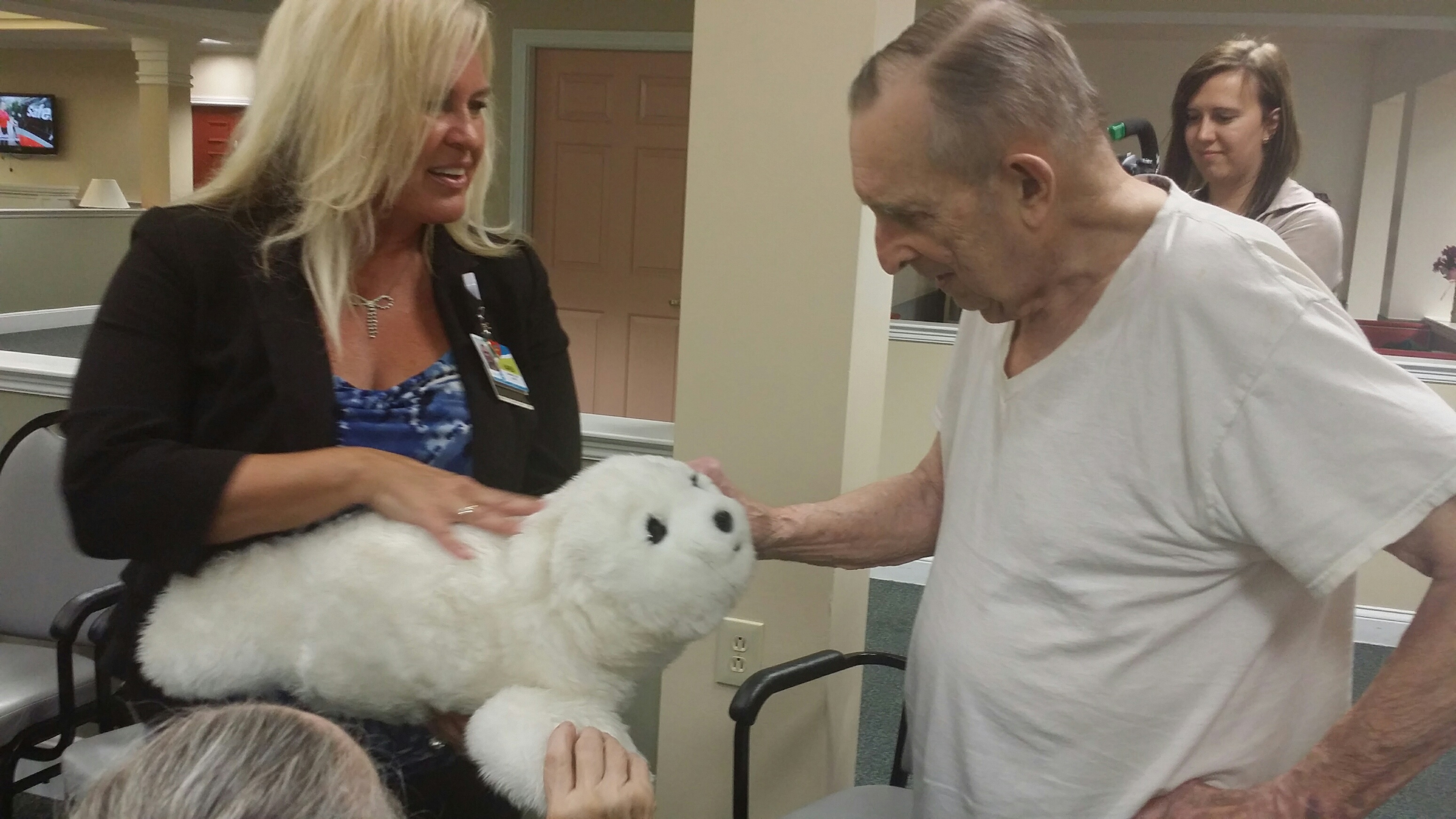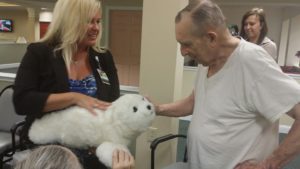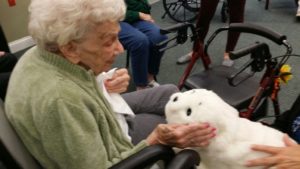
High-Tech Robotic Animal Assisted Therapy Benefits Patients
 There were quite a few questions from patients in the Memory Care Unit at Spring Hills Assisted Senior Living Facility in Middletown.
There were quite a few questions from patients in the Memory Care Unit at Spring Hills Assisted Senior Living Facility in Middletown.
“How old is she?”
“What is her name?”
“Where does she live?”
“What does she weigh?”
The focus of their curiosity were two furry, interactive, robotic animals that respond to touch and sound by purring, wagging flippers or tail, blinking eyes and making pleasant vocal sounds. The group of Memory Care patients was introduced to the robotic animals in a therapeutic session led by a member of the Ohio’s Hospice of Butler & Warren Counties staff.
Ohio’s Hospice affiliates employ a variety of complementary services to benefit patients. Research shows that those with Alzheimer’s or dementia can become socially isolated and retreat from human interaction. Emotional connection is a basic human need. Ohio’s Hospice has found robotic animals can offer a safe alternative to therapy involving real animals, which can be impractical in community living settings.
 A study of using robotic animal interventions by the National Center for Biotechnology Information concluded that most of the elderly people enjoyed interaction with the robots. Outcomes of their use as a therapy including a reduction in the level of stress and increased immune system response, improved mood and increased communication. In addition, some studies showed the robots reduced the severity of dementia.
A study of using robotic animal interventions by the National Center for Biotechnology Information concluded that most of the elderly people enjoyed interaction with the robots. Outcomes of their use as a therapy including a reduction in the level of stress and increased immune system response, improved mood and increased communication. In addition, some studies showed the robots reduced the severity of dementia.
Karen Parziale-McFall, a Community Liaison with Ohio’s Hospice of Butler & Warren Counties, offers visits with robotic animals to area extended care facilities. When she visits with the robotic seal Chloe and cat Mittens, she says her experience reflects similar responses. “I’ve seen patients respond to the Chloe the seal, when they have very little response to other stimuli. It has a calming effect on the resident and can help diffuse certain behaviors.” She says engagement with the robotic pets also stimulates increased social interaction. “When I bring Chloe and Mittens to visit the residents, it helps stimulate conversations and interactions between them. Many residents will start sharing fond memories about pets that they’ve owned in the past.”
At Spring Hills, some patients responded with significant interest in the robotic animals, speaking and stroking the plush coat of the robot. The more the person interacts with the robot, the more responsive the robot becomes.
Two robotic animals were introduced in the therapeutic session at Spring Hills. “Chloe” is a plush white baby seal with enormous and expressive eyes. Chloe purrs and wags flippers as patients stroke her and speak. Chloe turns her head in response to noise and blinks her eyes. A second robotic animal is a cat, which also blinks, purrs and meows as patients pet and speak. The physical demeanor of patients noticeably relaxes and becomes more animated as they interact with the robots and the robots respond.
According to Spring Hill Recreational Assistant Ashley Campbell, the robotic animal therapy helps patients in a number of ways. “Chloe and Mittens are good for both higher and lower functioning residents. We find them to be at least, if not more effective, than live pet therapy. It’s a great reminiscent activity for residents and gets them talking more. We also find they remain more engaged in other activities after Chloe and Mittens visit, and are smiling and laughing more.”
Robotic animal therapies are available at most Ohio’s Hospice affiliates. Please contact your local affiliate for more information by clicking here.
Author Profile
Latest entries
 Media ReleaseJanuary 1, 2024Community Hospice to Join Ohio’s Hospice Strategic Partnership
Media ReleaseJanuary 1, 2024Community Hospice to Join Ohio’s Hospice Strategic Partnership #CelebratingLifesStoriesNovember 21, 2023Priesthood, Shelters and Hospice Care: A Life of Service for Barbara Parini
#CelebratingLifesStoriesNovember 21, 2023Priesthood, Shelters and Hospice Care: A Life of Service for Barbara Parini News and UpdatesJuly 28, 2023Ohio’s Hospice Volunteer Experiences Hospice Care as a Loved One
News and UpdatesJuly 28, 2023Ohio’s Hospice Volunteer Experiences Hospice Care as a Loved One News and UpdatesJuly 19, 2023The Not-for-Profit Difference
News and UpdatesJuly 19, 2023The Not-for-Profit Difference

